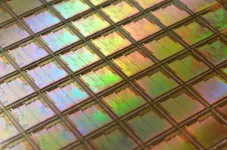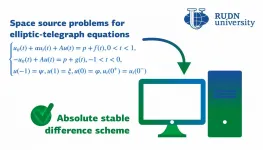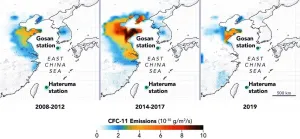INFORMATION:
Wafer-scale production of graphene-based photonic devices
Graphene Flagship researchers have devised a wafer-scale fabrication method that paves the way to the next generation of telecom and datacom devices.
2021-02-11
(Press-News.org) Our world needs reliable telecommunications more than ever before. However, classic devices have limitations in terms of size and cost and, especially, power consumption - which is directly related to greenhouse emissions. Graphene could change this and transform the future of broadband. Now, Graphene Flagship researchers have devised a wafer-scale fabrication technology that, thanks to predetermined graphene single-crystal templates, allows for integration into silicon wafers, enabling automation and paving the way to large scale production.
This work, published in the prestigious journal ACS Nano, is a great example of a collaboration fostered by the Graphene Flagship ecosystem. It counted on the participation of several Graphene Flagship partner institutions like CNIT and the Istituto Italiano di Tecnologia (IIT), in Italy, the Cambridge Graphene Centre at the University of Cambridge, UK, and Graphene Flagship Associated Member and spin-off CamGraphIC. Furthermore, Graphene Flagship-linked third party INPHOTEC and researchers at the Tecip Institute in Italy provided the graphene photonics integrated circuits fabrication. Through the Wafer-scale Integration Work Package and Spearhead Projects such as Metrograph, the Graphene Flagship fosters collaboration between academia and leading industries to develop high-technology readiness level prototypes and products, until they can reach market exploitation.
The new fabrication technique is enabled by the adoption of single-crystal graphene arrays. "Traditionally, when aiming at wafer-scale integration, one grows a wafer-sized layer of graphene and then transfer it onto silicon," explains Camilla Coletti, coordinator of IIT's Graphene Labs, who co-led the study. "Transferring an atom-thick layer of graphene over wafers while maintaining its integrity and quality is challenging" she adds. "The crystal seeding, growth and transfer technique adopted in this work ensures wafer-scale high-mobility graphene exactly where is needed: a great advantage for the scalable fabrication of photonic devices like modulators," continues Coletti.
It is estimated that, by 2023, the world will see over 28 billion connected devices, most of which will require 5G. These challenging requirements will demand new technologies. "Silicon and germanium alone have limitations; however, graphene provides many advantages," says Marco Romagnoli from Graphene Flagship partner CNIT, linked third party INPHOTEC, and associated member CamGraphiC, who co-led the study. "This methodology allows us to obtain over 12.000 graphene crystals in one wafer, matching the exact configuration and disposition we need for graphene-enabled photonic devices," he adds. Furthermore, the process is compatible with existing automated fabrication systems, which will accelerate its industrial uptake and implementation.
In another publication in Nature Communications, researchers from Graphene Flagship partners CNIT, Istituto Italiano di Tecnologia (IIT), in Italy, Nokia - including their teams in Italy and Germany, Graphene Flagship-linked third party INPHOTEC and researchers at Tecip, used this approach to demonstrate a practical implementation: "We used our technique to design high-speed graphene photodetectors," says Coletti. "Together, these advances will accelerate the commercial implementation of graphene-based photonic devices," she adds.
Graphene-enabled photonic devices offer several advantages. They absorb light from ultraviolet to the far-infrared - this allows for ultra-broadband communications. Graphene devices can have ultra-high mobility of carriers - electrons and holes - enabling data transmission that exceeds the best performing ethernet networks, breaking the barrier of 100 gigabits per second.
Reducing the energetic demands of telecom and datacom is fundamental to provide more sustainable solutions. At present, Information and communication technologies are already responsible for almost 4% of all greenhouse emissions, comparable to the carbon footprint of the airline industry, projected to increase to around 14% by 2040. "In graphene, almost all the energy of light can be converted into electric signals, which massively reduces power consumption and maximises efficiency," adds Romagnoli.
Frank Koppens, Graphene Flagship Leader for Photonics and Optoelectronics, says: "This is the first time that high-quality graphene has been integrated on the wafer-scale. The work shows direct relevance by revealing high-yield and high-speed absorption modulators. These impressive achievements bring commercialisation of graphene devices into 5G communications very close."
Andrea C. Ferrari, Science and Technology Officer of the Graphene Flagship and Chair of its Management Panel added: "This work is a major milestone for the Graphene Flagship. A close collaboration between academic and industrial partners has finally developed a wafer-scale process for graphene integration. The Graphene Foundry is no more a distant goal, but it starts today."
ELSE PRESS RELEASES FROM THIS DATE:
- How we sleep and experience psychological symptoms during pandemic
2021-02-11
During the first confinement (18 March to 10 May 2020), people who reported worse sleep quality during a night also reported an increase in negative mood, psychotic-type like experiences and somatic complaints on the next day. Furthermore, daily reports of deaths caused by Covid-19 predicted psychological symptoms on the same day and sleep quality the following night. This is the result of research carried out in three countries (Belgium, Hungary, Spain) under direction of Peter Simor with researchers at the Université libre de Bruxelles (ULB), Rebeca Sifuentes-Ortega, Ariadna Albajara Saenz, Oumaïma Benkirane, Anke Van Roy and Philippe Peigneux from the CRCN (Center for Research in Cognition and Neurosciences) and the UNI (ULB Neurosciences Institute) ...
Smartphone app to change your personality
2021-02-11
Personality traits such as conscientiousness or sociability are patterns of experience and behavior that can change throughout our lives. Individual changes usually take place slowly as people gradually adapt to the demands of society and their environment. However, it is unclear whether certain personality traits can also be psychologically influenced in a short-term and targeted manner.
Researchers from the universities of Zurich, St. Gallen, Brandeis, Illinois, and ETH Zurich have now investigated this question using a digital intervention. In their study, around 1,500 participants were provided with a specially developed smartphone app for three months and the researchers then assessed whether and ...
RUDN University mathematician suggested a scheme for solving telegraph equations
2021-02-11
A mathematician from RUDN University suggested a stable difference scheme for solving inverse problems for elliptic-telegraph and differential equations that are used to describe biological, physical, and sociological processes. The results of the study were published in the Numerical Methods for Partial Differential Equations journal.
Elliptic equations are a class of differential equations in partial derivatives that are used, among other things, to model time-independent processes. Telegraph equations are presented in a nonstationary form. They were initially obtained for a telegraph communication line, but today they are also used to model the movement of insects, the flow of blood ...
Ionic liquid uniformly delivers chemotherapy to tumors while destroying cancerous tissue
2021-02-11
PHOENIX -- A Mayo Clinic team, led by Rahmi Oklu, M.D., Ph.D., a vascular and interventional radiologist at Mayo Clinic, in collaboration with Samir Mitragotri, Ph.D., of Harvard University, report the development of a new ionic liquid formulation that killed cancer cells and allowed uniform distribution of a chemotherapy drug into liver tumors and other solid tumors in the lab. This discovery could solve a problem that has long plagued drug delivery to tumors and provide new hope to patients with liver cancer awaiting a liver transplant. The preclinical study results are published in Science Translational Medicine.
Dr. Oklu, study author and director of Mayo Clinic's ...
Emissions of banned ozone-depleting substance back on decline
2021-02-11
Two international studies of a consortium including more than a dozen institutions the world over, including Empa, published today in the journal Nature show levels of CFC-11 emissions, one of many chlorofluorocarbon (CFC) chemicals once widely used in refrigerators and insulating foams, are back on the decline - less than two years after their shock resurgence in the wake of suspected rogue production in eastern China was widely publicized.
"The findings are very welcome news and hopefully mark an end to a disturbing period of apparent regulatory breaches", says Luke Western from the University of Bristol, a ...
Small is big: the need for a holistic approach to manage cerebral small vessel disease
2021-02-11
Cerebral small vessel disease (SVD) is characterized by damage to the blood vessels and parenchyma in the brain. It presents as a multitude of symptoms, which makes the diagnosis difficult. Matters are complicated further when SVD sets in along with other comorbidities with similar symptoms. Therefore, accurate diagnosis at an early stage of disease progression helps in defining better prognosis and management strategies for patients with cerebral SVD.
A team of researchers from the United Kingdom set out to review more than 10,000 studies on clinical diagnosis, risk factors, progression, and intervention ...
A study analyses breakfast-related advertising in Mediterranean countries
2021-02-11
Experts have spent decades warning us about the rising rates of childhood obesity, which has become an epidemic among recent generations in many places around the world, including Spain. The transition from the traditional Mediterranean diet to the consumption of processed foods with low nutritional value is a key contributor, with child-targeted advertising also partly to blame. According to the Breakfast Food Advertisements in Mediterranean Countries: Products' Sugar Content in Adverts from 2015 to 2019 report produced by UOC Faculty of Information and Communication Sciences professor and researcher, Mireia Montaña, the majority of breakfast products ...
Swirlonic super particles baffle physicists
2021-02-11
In recent years, active, self-propelled particles have received growing interest amongst the scientific community. Examples of active particles and their systems are numerous and very diverse, ranging from bacterium films to flocks of birds or human crowds. These systems can demonstrate unusual behavior, which is challenging to understand or model.
To this end, large-scale models of active particles were being scrutinised by experts at Leicester, in order to understand basic principles underlying active particle dynamics and apply them in a scenario of an evacuation strategy for customers in crowded place. Unexpectedly, the 'super-particles' milling in a circular motion were stumbled upon ...
The power of groupthink: Study shows why ideas spread in social networks
2021-02-11
There's a reason that ideas--even erroneous ones--catch fire on social media or in popular culture: groupthink.
New research co-authored by Berkeley Haas Asst. Prof. Douglas Guilbeault shows that large groups of people all tend to think alike, and also illustrates how easily people's opinions can be swayed by social media--even by artificial users known as bots.
In a series of experiments, published in the journal Nature Communications, Guilbeault and co-authors Damon Centola of the University of Pennsylvania and Andrea Baronchelli of City University London created an online game that asked numerous people to identify ...
Infectious disease causes long-term changes to frog's microbiome
2021-02-11
Just as beneficial microbes in the human gut can be affected by antibiotics, diet interventions and other disturbances, the microbiomes of other animals can also be upset. In a rare study published this week, Andrea Jani, a researcher with the University of Hawai'i at Mānoa School of Ocean and Earth Science and Technology (SOEST), determined the skin microbiome of an endangered frog was altered when the frogs were infected by a specific fungus, and it didn't recover to its initial state even when the frog was cured of the infection.
All animals host symbiotic microbes--many ...
LAST 30 PRESS RELEASES:
Scientists use ultrasound to soften and treat cancer tumors without damaging healthy tissue
Community swimming program for Black youth boosts skills, sense of belonging, study finds
Specific depressive symptoms in midlife linked to increased dementia risk
An ‘illuminating’ design sheds light on cholesterol
Who is more likely to get long COVID?
Study showcases resilience and rapid growth of “living rocks”
Naval Research Lab diver earns Office of Naval Research 2025 Sailor of the Year
New Mayo-led study establishes practical definition for rapidly progressive dementia
Fossil fuel industry’s “climate false solutions” reinforce its power and aggravate environmental injustice
Researchers reveal bias in a widely used measure of algorithm performance
Alcohol causes cancer. A study from IOCB Prague confirms damage to DNA and shows how cells defend against it
Hidden viruses in wastewater treatment may shape public health risks, study finds
Unlock the power of nature: how biomass can transform climate mitigation
Biochar reshapes hidden soil microbes that capture carbon dioxide in farmland
Reducing saturated fat intake shows mortality benefit, but only in high-risk individuals
Manta rays create mobile ecosystems, study finds
Study: Mixed results in using lipoic acid to treat progressive multiple sclerosis
Norbert Holtkamp appointed director of Fermi National Accelerator Laboratory
New agentic AI platform accelerates advanced optics design
Biologists discover neurons use physical signals — not electricity — to stabilize communication
Researchers discover that a hormone can access the brain by hitchhiking
University of Oklahoma researcher awarded funding to pursue AI-powered material design
Exploring how the visual system recovers following injury
Support for parents with infants at pediatric check-ups leads to better reading and math skills in elementary school
Kids’ behavioral health is a growing share of family health costs
Day & night: Cancer disrupts the brain’s natural rhythm
COVID-19 vaccination significantly reduces risk to pregnant women and baby
The role of vaccination in maternal and perinatal outcomes associated with COVID-19 in pregnancy
Mayo Clinic smartwatch system helps parents shorten and defuse children's severe tantrums early
Behavioral health spending spikes to 40% of all children’s health expenditures, nearly doubling in a decade
[Press-News.org] Wafer-scale production of graphene-based photonic devicesGraphene Flagship researchers have devised a wafer-scale fabrication method that paves the way to the next generation of telecom and datacom devices.




